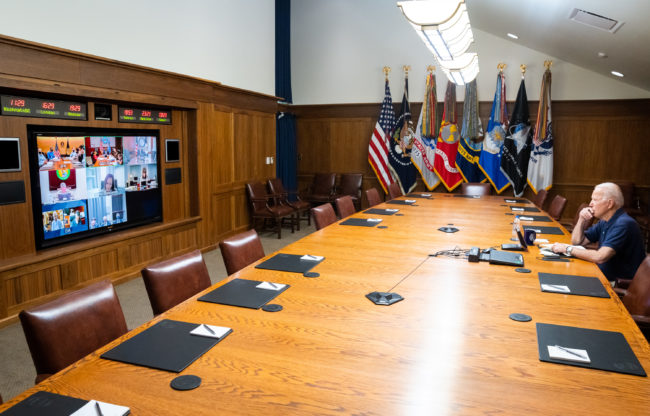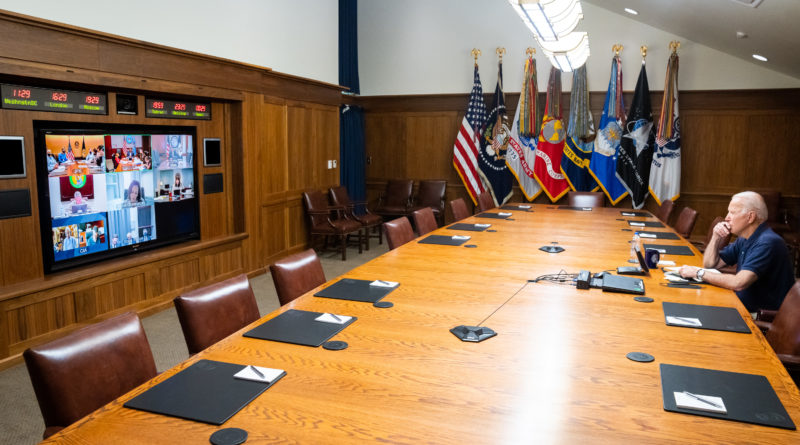Afghanistan. A severe defeat for NATO. Introspection is needed (v2)
(B2) The collapse of the Afghan government and security forces, supported at arm's length for almost twenty years by the USA and the Western Allies, is a cause for concern. Resting the failure on Joe Biden's head alone is a decoy. A real questioning is called for

Blaming the Americans today for a hasty departure, as some politicians (especially in Europe) or observers are currently doing, is a quick shortcut. If there is defeat, it is first of all that of the Afghan government of Ashraf Ghani, and its army, supported by all Westerners. The Najibullah government - backed by the Russians - held out three years after the Russian withdrawal (in 1989). The Ghani government will have lasted barely a few weeks in 2021. The Afghan army, supported and trained by the Americans and NATO, has collapsed. It is therefore a Western defeat as a whole. The longest and most important of the operations of the Atlantic Alliance ends in a rout. The error is not only tactical, it is strategic.
An announced and gradual US withdrawal
Sets off under Obama
Contrary to what is indicated — the American military withdrawal was not sudden. It was progressive and announced. It was a promise from Democrat Barack Obama: to put an end to the wars started under the Bush era (Iraq and Afghanistan) and bring back all the Americans at home. On June 22, 2011, the Democratic president announced the withdrawal of a third of the 100.000 Americans present on the spot (as part of the coalition or alone). Objective: a total withdrawal by the end of 2014. An announcement that fits with the electoral campaign for his new mandate (elections in November 2012). In the process, several countries, including France, announced their withdrawal. In October 2015, an about-face, Washington announced the maintenance of a workforce at a level of around 10.000 men.
Taken over by Donald Trump
During his election campaign, the Republican Donald Trump took up a leitmotif similar to that of his Democratic competitor: to put an end to unnecessary military presences abroad (read: Trump's "America First". For Europe, a certain language of truth). There too, the ground is right for the political promise. On August 21, 2017, the President announced a “ new policy for Afghanistan and reaffirms the commitment and deployment of a few thousand additional men. In 2017, the US workforce still reached approximately 14.000 personnel (including 8500 in Resolute Support, the rest in the counter-terrorism mission). Future withdrawals will now be tied to “ field conditions ". In the wake of the peace negotiations started in Doha with the Taliban, he resumed his anthem from the beginning and announced, on October 17, 2020, the return of the troops to the house " by christmas '(' We should have the small remaining number of our BRAVE Men and Women serving in Afghanistan home by Christmas "). More concretely, the term is given at the end of April (before May 1). Before his departure, he ordered the departure of several hundred US soldiers, leaving only 2500 on the spot, mainly in Kabul.
And buckled under Joe Biden
The alternation with Joe Biden (elected in early November 2020) does not fundamentally change the situation. The one who, under Obama, as vice-president, was one of the most ardent defenders of the military decline in Afghanistan, postpones the date of May 1, " difficult " to respect. He simply gives himself a few months when he takes office (in January 2021) to validate the withdrawal planned by his predecessor. He announces his decision on April 13, 2021, with a slightly spread schedule. Departure " without conditions between now and September 11, the anniversary of the attack of September 11, 2001. Most of the troops will be withdrawn before the beginning of July (and the US national holiday of July 4). Talking about a surprise withdrawal is therefore surprising...
The end of the stabilization operation
This relay to the Afghan forces was also endorsed by the end of the NATO stabilization operation (ISAF) in 2015 and its replacement by a 'non-executive' mission (Resolute Support or RSM). Objective: to train, advise and assist the Afghan Defense and National Security Forces (ANDSF). Scheduled until 2016, this mission is then extended until the end of 2020 (at the Warsaw summit), with an emphasis on the more tactical aspect. The mission ends in May 2021, with the withdrawal of Western forces. All the allies approve of this withdrawal or, at least, do not express any public criticism or offer an alternative. (Also read: The withdrawal of NATO from Afghanistan decided. Resolute Support mission ends et NATO promises not to abandon Afghanistan. Training and support continues).
Poor Afghan power and army
After twenty years of Euro-Atlantic support at arm's length, the Afghan forces remain ineffective. The word is weak. Even if the information is laconic in public official reports, reality oozes out.
Poor leadership
The Afghan National Army (ANA) has a " poor leadership ". The soldiers are disappointed in leaders who don't look after them with time off, promotions and salaries ". There are " current corrupt and/or incompetent leaders (US Congress report, 2017). Politically, the governance of Afghanistan is " failing » with corruption and « 47% of the territory not controlled by the central power, 19% being in the hands of the Taliban (Coface, 2020).
An army in permanent renewal
The attrition rate (losses in combat, desertion and other departures) is ranked " top secret by the Afghan authorities (1) (SIGAR US, June 2021). But there remains at a high level (PA-NATO, 2018). We are talking about a rate of 2,8% monthly (SIGAR US, June 2019). That is to say that the army loses a third of its workforce every year. THE " high turnover rate (25 to 30% per year) « prevents the ANDSF [Afghan Defense and National Security Forces] to have more experienced forces (ibid).
... and abused by power
The cause of this lack of enthusiasm of the recruits is multiple: the recurrence of long-term deployments, the prospect of having to participate in combat operations on an almost permanent basis and the difficult living conditions as well as the obligation for soldiers to serve outside their region of origin (ibid). Not to mention " fraud and waste recurrent in Afghanistan, which also affect the security forces (GAO US, 2021).
Capacity shortfalls
As a result, the armed forces suffer from certain shortcomings and depend on their allies for essential means of action: intelligence, surveillance and reconnaissance (ISR), artillery systems, aerial fire support, logistical support, in particular aerial evacuation means medical (US Defense, 2017). This, despite a significant financial contribution. Not less than " 84 billion have been invested in security by the US government alone, in 17 years from 2002 to 2018 (GAO US, 2021)!
An overvaluation of capacities
The Allied forces, however, were in the dark about the effectiveness of their support. The US and coalition advisers had " few direct contacts "with conventional units" on the front lines ". As a result, the Ministry of Defense relied, to assess the tactical capabilities of units formed on " self-assessments, which DOD officials say may not be reliable (GAO US, 2018).
Western denial et the boomerang effect of propaganda
Certainly, the English Language military official has long tried to deceive. Back from Kabul in February 2018, US General Curtis Scaparrotti, Supreme Allied Commander Europe (SHAPE), said he was convinced that “ the Taliban could not prevail on the battlefield »! This propaganda, aimed at the outside, resulted in a form of self-conviction which no doubt explains today the effect of surprise at the speed of the Taliban advance.
cascading errors
The defeat in the face of Afghan power is therefore not so much a problem of the suddenness of the withdrawal, but rather of its lateness and strategic errors. Would a presence of several years have changed the situation? Not sure at all. We are faced with errors not only tactical, but also strategic, political.
A fluctuating war aim
The operation started in 2001, the day after the September 11 attacks in New York against the world trade center and Washington, initially conceived as an anti-terrorist operation targeted at the bin Laden network, has evolved into a civil-military transformation operation of a country - supposed to be a buffer state between an evil Iran and the republics of Asia considered too close to Moscow - the fight against the Taliban, the reconstruction of a State, the setting up of a national army and a national police, etc. There was therefore not what is called at the military level the desired end state (Defined End State). Or else this one was so wide and so blurry that it was not tenable.
A lack of an exit strategy
Consequence: the exit strategy was very vague. The release schedules have been questioned, interrupted or rescheduled on several occasions. They gave the Afghan authorities the impression that Western engagement would be ad vitam aeternam.
Poor training
Was the effort undertaken since 2002 to train and supervise an Afghan national army useful, effective, solid? Was the chosen concept of a large 'national' army valid? Didn't we prefer the number to the quality? Wanting to solidify a very fragmented state, by setting up a national army, without relying on the traditional organization by province, was it possible? Etc. Solid introspection must be carried out at the Euro-Atlantic level, to avoid repeating mistakes elsewhere.
A surplus of help
The flow of international aid — military, security, development, humanitarian — to Afghanistan has been so great that it has rendered the country entirely dependent. All international donations represented in 2020 43% of Afghan GDP (19,81 billion dollars) and 50% of tax revenue is based on international aid according to a note Coface. One can wonder whether this aid was absorbable by the country and whether, instead of developing the country, it did not put it under assistance.
A limited capacity for European autonomy
Finally, this episode is the stinging illustration that, despite all the rhetoric, in the event of strong tension, the Europeans are still incapable today of having strategic autonomy, both politically and militarily. They were unable to influence American strategy on the ground in the long term, nor succeeded in finding autonomy of action. During the various NATO meetings, in 2020 and 2021, they did not really criticize the US decision to withdraw. NATO's principle of 'all together' has been transformed into a realistic rule: the USA leads, the Europeans follow.
(Nicolas Gros-Verheyde)
- « USFOR-A continued to classify detailed ANDSF attrition information this quarter because the Afghan government classifies it »
- SIGAR = Special Inspector General for Afghanistan Reconstruction
Completed with the paragraph on international assistance


